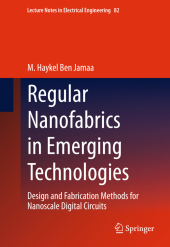 Neuerscheinungen 2013Stand: 2020-01-07 |
Schnellsuche
ISBN/Stichwort/Autor
|
Herderstraße 10
10625 Berlin
Tel.: 030 315 714 16
Fax 030 315 714 14
info@buchspektrum.de |

M. Haykel Ben Jamaa
Regular Nanofabrics in Emerging Technologies
Design and Fabrication Methods for Nanoscale Digital Circuits
2013. xx, 192 S. 16 Tabellen. 235 mm
Verlag/Jahr: SPRINGER NETHERLANDS; SPRINGER, BERLIN 2013
ISBN: 9400735707 (9400735707)
Neue ISBN: 978-9400735705 (9789400735705)
Preis und Lieferzeit: Bitte klicken
This book presents two technologies as potential candidates for future semiconductor devices and systems. It shows how fabrication issues can be addressed at the design level and vice versa, and explains processing, circuit and system level design.
Regular Nanofabrics in Emerging Technologies gives a deep insight into both fabrication and design aspects of emerging semiconductor technologies, that represent potential candidates for the post-CMOS era. Its approach is unique, across different fields, and it offers a synergetic view for a public of different communities ranging from technologists, to circuit designers, and computer scientists. The book presents two technologies as potential candidates for future semiconductor devices and systems and it shows how fabrication issues can be addressed at the design level and vice versa. The reader either for academic or research purposes will find novel material that is explained carefully for both experts and non-initiated readers. Regular Nanofabrics in Emerging Technologies is a survey of post-CMOS technologies. It explains processing, circuit and system level design for people with various backgrounds.
Acknowledgments. Contents. List of Figures. List of Tables.
1 Introduction. 1.1 The Linear Scaling. 1.2 The Latest Milestones. 1.3 Emerging technologies. 1.4 Regular Architectures and Fabrics. 1.5 Challenges of Regular Emerging Architectures. 1.6 Organization of the Book. References.
2 Fabrication of Nanowire Crossbars. 2.1 Nanowire Fabrication Techniques. 2.2 Crossbar Technologies. 2.3 Fabrication Facilities at EPFL. 2.4 Process Flow. 2.5 Process Optimization. 2.6 Device Characterization. 2.7 Potential Applications. 2.8 Discussions. 2.9 Chapter Contributions and Summary. References.
3 Decoder Logic Design. 3.1 Crossbar Architecture. 3.2 Decoder and Encoding Types. 3.3 Multi-Valued Logic Encoding. 3.4 The MSPT Decoder. 3.5 Discussions. 3.6 Chapter Contributions and Summary. References.
4 Decoder Test. 4.1 Necessity of Testing Crossbar Circuits. 4.2 Testing Crossbar Circuits. 4.3 Perturbative Current Model. 4.4 Stochastic Current Model. 4.5 Model Implementation. 4.6 Simulation Results. 4.7 Discussions. 4.8 Chapter Contributions and Summary. References.
5 Logic Design with Ambipolar Devices. 5.1 Logic Circuits with Carbon Nanotubes. 5.2 Ambipolar CNTFETs. 5.3 Dynamic Logic with Ambipolar CNTFETs. 5.4 Static Logic with Ambipolar CNTFETs. 5.5 Multi-Level Logic Synthesis with Static CNTFET Gates. 5.6 Design of Regular Fabrics. 5.7 Discussions. 5.8 Chapter Contributions and Summary. References.
6 Conclusions and Future Work. 6.1 Book Summary and Contributions. 6.2 Future Work.
List of Acronyms. List of Symbols.


